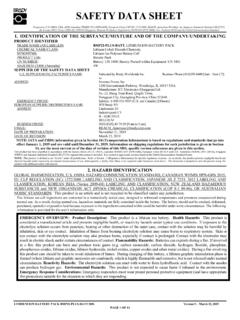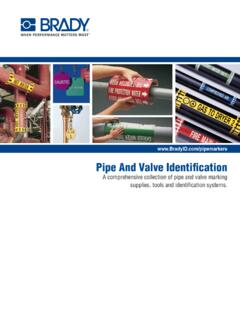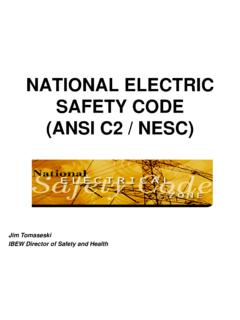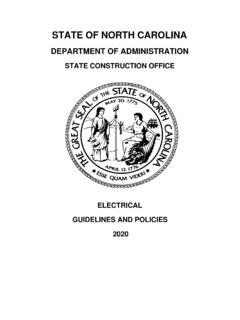Transcription of WORKPLACE GUIDE TO ARC FLASH
1 THEWORKPLACE GUIDE TOARC FLASHSAFETYGet answers to your arc ash and NFPA 70E questionsTABLE OF CONTENTSC hapter 1: Understanding Arc FLASH 3 What is Arc FLASH ? How Can an Arc FLASH Occur? What Impacts the Size of an Arc FLASH Event? What are the Dangers of an Arc FLASH Event?Chapter 2: The NFPA 70E Standard 6 What is NFPA 70E? What Does the NFPA 70E Standard Include?Chapter 3: Risk Assessments 8 Why is a Risk Assessment Performed? What is a Risk Assessment? What is an Arc FLASH Boundary? What is the Next Step?Chapter 4: Arc FLASH Labeling 12 Who is Responsible for Labeling? What Should be Labeled? What if Electrical Equipment is Updated? Where Should Labels be Placed? What Label Format Should be Used? What ANSI Header Should be Used? How Durable Should Labels Be? What Should Appear on an Arc FLASH Label?
2 Chapter 5: WORKPLACE Solutions 21 What are Some Labeling Options? Who Should Perform Arc FLASH Risk Assessments?With the rising frequency of reported arc FLASH accidents, and the potential for serious injury or death, arc FLASH is a serious concern. It's important to increase safety and compliance in your WORKPLACE by better understanding and identifying arc FLASH hazards. In this GUIDE , get answers to your questions and learn more about arc FLASH events, the NFPA 70E standard, and how to reach compliance with labeling and risk 13 UNDERSTANDING ARC FLASHU nderstanding Arc FLASH What is Arc FLASH ? ARC FLASH : A short circuit through air that flashes over from one exposed live conductor to another conductor or to ground. This electrical fault can create a dangerous release of energy, including thermal energy, acoustical energy, pressure wave or Can an Arc FLASH Occur?
3 There are a number of ways an arc FLASH can occur, including: Coming close to a high-amp source with a conductive object can cause the electricity to FLASH over Dropping a tool or creating a spark can ignite an arc FLASH Failing equipment due to use of substandard parts, improper installation, or even normal wear and tear Breaks or gaps in insulation Dust, corrosion or other impurities on the surface of the conductorWhat Impacts the Size of an Arc FLASH Event?Common variables that impact the size and energy of an arc FLASH include1: Amperage Voltage Arc Gap Closure Time Distance from Arc 3 Phase vs. Single Phase Confined SpaceDID YOU KNOW? An average of 30,000 arc FLASH incidents occur per 1 / 4 What are the Dangers of an Arc FLASH Event? Physical InjuryWithout the proper labeling, training and personal protective equipment (PPE), an arc FLASH occurrence can lead to serious burn injuries, concussions, hearing loss, shrapnel injuries, broken bones and even death.
4 An arc FLASH occurrence can reach thousands of degrees, and skin exposure for just 1/10 of a second at 203 F can lead to third degree burns. To help keep your WORKPLACE safe, train your employees in safe work practices and utilize labels and awareness to keep the message in the forefront of your workers minds and reinforce the desired behavior in your ImpactAn arc FLASH occurrence can have a productivity and financial impact as well. Total costs for arc FLASH accidents can range from $12-15 million, including medical expenses, downtime, equipment replacement, lawsuits, and insurance and litigation fees4. According to the Occupational Safety and Health Administration (OSHA), some facilities have been fined for over $500K for not being compliant with electrical safety regulations. Chapter 1 / 5 DID YOU KNOW?
5 Arc FLASH incidents lead to over 2,000 hospitalizations. An average hospital stay is 19 days, at approximately $18,000 per 2 THE NFPA 70 ESTANDARDThe NFPA 70E Standard What is NFPA 70E?OSHA cites and fines employers for failure to protect employees from the dangers of arc FLASH under regulation 29 CFR (a). The National Fire Protection Association (NFPA) details how to comply with this regulation through the NFPA 70E standard, Standard for Electrical Safety in the WORKPLACE . What Does the NFPA 70E Standard Include?According to the NFPA 70E standard, there are six primary responsibilities that facilities must meet, including: 1. Training for employees 2. Written safety program in place that is actionable 3. PPE available for employees 4. Insulated tools 5. Arc FLASH hazard degree calculations 6.
6 Properly labeled equipmentLearn more about how risk assessments and labeling can help you reach compliance in the following 2 / 7 DID YOU KNOW? An arc FLASH event can reach35,000 F18 CHAPTER 3 ARC FLASH RISKASSESSMENTSArc FLASH Risk Assessments Why is a Risk Assessment Performed?An arc FLASH risk assessment is done for many reasons, including: 1. To prevent worker injury or death 2. To minimize equipment damage 3. To minimize system downtime 4. To comply with codes and safety regulations 5. To meet insurance requirements 6. To avoid litigation expensesWhat is a Risk Assessment?An arc FLASH risk assessment is a key part of what OSHA requires as it relates to electrical hazards. NFPA 70E requires employers to conduct an arc FLASH risk assessment to determine the amount of thermal energy that could be generated from an arc FLASH incident.
7 This information is then used to define a FLASH protection boundary around the potential source and determine the level of arc-rated apparel and other PPE required to protect employees who cross the boundary from the potential heat, light and blast of an minimum, the safety program needs to be audited at intervals not to exceed 3 years and arc FLASH risk assessments shall be periodically reviewed at intervals not to exceed 5 years. Chapter 3 / 9 What is an Arc FLASH Boundary? An arc FLASH boundary is the distance at which an electrical arc can FLASH outward and endanger employees working on electrical equipment. Additional boundary requirements include: Conductive Articles of Jewelry and Clothing: Watchbands, bracelets, rings, key chains, necklaces, metal frame glasses, etc. shall not be worn within the restricted approach boundary.
8 Working Space: Shall not be used for storage. Space shall be kept clear to permit safe operation and maintenance. Barricades: When the arc FLASH boundary is greater than the limited approach boundary, barricades shall not be placed closer than the arc FLASH boundary. Insulated Tools: Employees shall use insulated tools when working inside the restricted approach boundary of exposed energized electrical 3 / 10 What is the Next Step?Once an arc FLASH risk assessment has been conducted, in which the arc FLASH boundary, the incident energy at the working distance and the personal protective equipment required has been determined, the label must then contain these important elements. Take a look at the below visual to learn more about each boundary area:Chapter 3 / 11 DID YOU KNOW? of electrical worker fatalities are due to burns, not 1.
9 Exposed Conductor, or Circuit2. Restricted Approach Boundary (increased likelihood of electric shock)3. Limited Approach Boundary (shock hazard exists)4. Arc FLASH Boundary (distance where up to 2nd degree burns are likely to occur - it could be 1 inch to 20 feet and greater of less than the other boundaries, depending on incident energy)WALL123412 CHAPTER 4 ARC FLASHLABELINGArc FLASH LabelingWho is Responsible for Labeling?Arc FLASH labeling is the responsibility of the employer, not the manufacturer or installer of the equipment. What Should be Labeled?The regulation states that relevant electrical equipment shall be field marked to warn qualified persons of potential electric arc FLASH hazards. Labeling is required for any piece of electrical equipment that is likely to require examination, adjustment, service or maintenance while energized, creating the potential for an arc FLASH incident to occur.
10 Thus, many employers are also labeling bus ducts and other electrical equipment not specifically called out in the NEC provides the following examples of electrical equipment that must be field marked with a warning label: Switchboards Panel Boards Motor Control Centers Industrial Control Panels Meter Socket Enclosures And MoreChapter 4 / 13 DID YOU KNOW? Exposure of 203 F for just one-tenth of a second (6 cycles) is enough to cause a third degree if Electrical Equipment is Updated?Any modifications or renovations to electrical equipment that will change data on the label will require an updated arc FLASH risk assessment and label according to the NFPA 70E standard. Unless changes to the electrical distribution system render the label inaccurate, labels applied prior to the effective date of the current NFPA standard are acceptable if they complied with the standard version in effect at the time the labels were applied.















